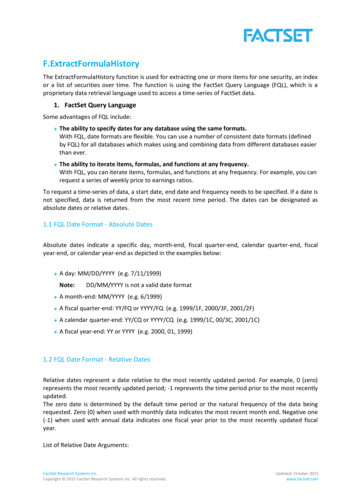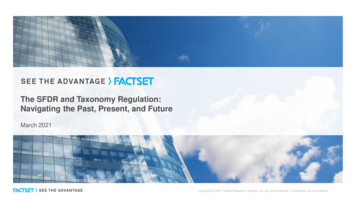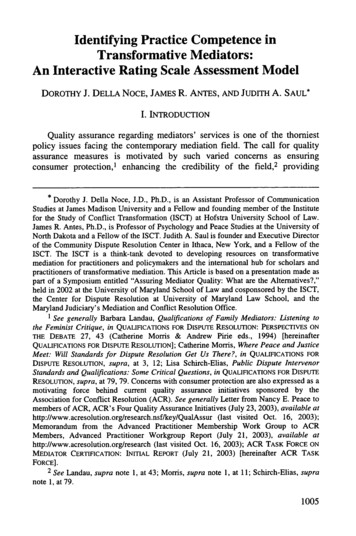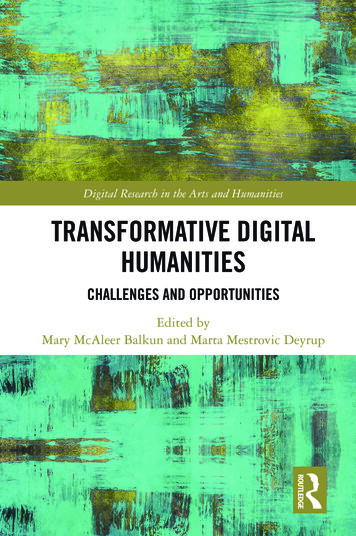
Transcription
T R A N S F O R M AT I V E T E C H N O L O G Y:E X P L O R I N G I N N O VAT I O N D I S R U P T I O NIN FINANCIAL SERVICESA survey of technology adoption in the investment industryamid the COVID-19 crisis1E X P L O R I N G I N N O VAT I O N D I S R U P T I O N I N F I N A N C I A L S E R V I C E S
INTRODUCTIONFacing myriad headwinds—fee compression, a tsunami of innovativeproducts and services, increasingly demanding customers, not tomention a global pandemic—it’s time for the financial industry toharness advanced technologies and embrace digital transformation.Today’s technologies are leading to outright breakthroughs. Considerthe exponential rise of powerful, scalable, and consumption-pricedtechnologies such as cloud computing, data lakes, and specializedsoftware-as-a-service (SaaS). These enable cognitive capabilities suchas artificial intelligence (AI), natural language processing (NLP), and realtime, predictive business intelligence (BI). The most advanced leadersare already well ahead in technological innovation and are seeing deeperinsight, higher confidence in decision making, reduced costs, greateragility, stronger performance, and even disruption.Our research (executed at the height of the COVID-19 crisis) showsthat this pandemic is partly responsible for sparking greater demandand the need for fully digital end-to-end business models. This meansthe digitization of a greater swath of back-office processes but alsothe ability to deliver a completely digital customer experience. Amidthe scramble to respond, leaders are demonstrating just how muchtechnology can strengthen a business and why accelerating theirdigital transformation efforts is critical.To better understand where firms lie on their digital transformationjourneys and how they’re leveraging technologies and externalpartners, FactSet commissioned Forbes Insights to survey 201 assetmanagers and asset owners from around the globe. More than threein five respondents were C-level executives, including 21% of CEOs orpresidents. All executives were from firms with at least 5 billion inassets under management.During our analysis, we identified a segment of “technology leaders”whom we’ll reference throughout the report. This group, based onthe technology leaders’ responses to key questions, is in the highestquartile of technology implementation, demonstrating leadership ineverything from advanced data platforms to AI, NLP, and blockchain.This report highlights those leaders’ successes and how companiesare implementing advanced technologies to manage increasedcompetitive pressures, develop insights, reduce costs, solve businesschallenges, and digitally energize the customer experience. Thesefindings lead the way for other organizations during or beginning theirdigital transformations.2E X P L O R I N G I N N O VAT I O N D I S R U P T I O N I N F I N A N C I A L S E R V I C E S
SECTION 1A C H A L L EN G IN G L A ND S C A P E F O RT HE IN V ES T MEN T IND U S T R Y3E X P L O R I N G I N N O VAT I O N D I S R U P T I O N I N F I N A N C I A L S E R V I C E S
Before discussing the role technology plays today, let’s first look atthe headwinds facing the financial industry.Seven out of 10 (69%) asset managers, asset owners, and sell-sidefirms say they are seeing significantly greater competitive pressurethan in the past. Numerous factors are driving this change, including: Customers expecting higher levels of digital service (79%) Competitors offering innovative products and services (77%) Customers demanding lower fees (76%) Customers expecting higher levels of personalized service (74%)Among the technology leaders segment we mentioned earlier, 86%are seeing greater competitive pressure as a result of these factors.Without question, technology leaders view digital transformationas an opportunity. As a result, not only are they more aggressivelyharnessing a wider range of new technologies, but they are also morefocused on strategic areas like improving the customer experience,optimizing costs, and developing new products and services (Fig. 1).of financial professionals saythey are seeing significantlygreater competitive pressurethan in the past.Overall, 85% of executives believe technology is playing a vital rolein shaping the financial industry’s future. This number rises to 98%among technology leaders—suggesting an industry recognizingthe need to leverage innovative technologies to expand customerservices while simultaneously shrinking operating costs.F I G U R E 1: T E C H N O LO GY L E A D E R S A R E M O V I N G M O R E A G G R E S S I V E LYTo what degree are you pursuing the following strategies (“high” and “aggressive” pursuit only)?83%Expanding digital services90%Optimizing our mix of productcosts/pricing/channels81%88%79%Improving the customer experienceDeveloping new products/services/markets77%94%71%Reducing costsOutsourcing back-office processes84%58%80%Overall4E X P L O R I N G I N N O VAT I O N D I S R U P T I O N I N F I N A N C I A L S E R V I C E S94%Leaders
Another challenge facing the industry is the decision whether to buy or build. Investment firms are increasinglylooking at sourcing third-party solutions to support workflow functions. Firms are already outsourcing solutionsfor everything from regulatory compliance (41%) to quantitative research (39%), data solutions (39%), and portfolioanalytics (39%). Overall, quantitative research is the most likely to be outsourced, with 74% of firms currentlyoutsourcing or likely to outsource it in the near future. Going forward, even more firms will be using third-party toolsacross more of their functions, further distributing their technology footprint (Fig. 2).F I G U R E 2 : F R O M I N - H O U S E TO O U T S O U R C E DCurrently OutsourcedLikely To Be erformanceMeasurement32%Overall543%41%LeadersE X P L O R I N G I N N O VAT I O N D I S R U P T I O N I N F I N A N C I A L S E R V I C E erallLeaders43%
A C O N V E R S AT I O N W I T HFAC T SE T: UNDERS TANDING DIGITALTR ANSFORMATION“Digital transformation,” says Gene Fernandez, executive VP andchief technology and product officer at FactSet, “is the creation ofnew business models, products, and processes that harness thepower of technology to enable people to do their best work.” Suchtechnologies “create seamless client interactions that removefriction from business processes,” Fernandez adds. This, in turn,“enables growth and automation that drives efficiency.”Though the trend toward digital transformation has been gainingmomentum for some time, Fernandez notes that “the COVID-19 crisis,which was in full swing as our survey was being conducted, is provingto be (and will likely remain) a powerful catalyst. Customers want moredigital services, and as more companies find out how effective digitalbusiness models can be, the trend will gain even more momentum.”“ Digital transformation is thecreation of new businessmodels, products, andprocesses that harness thepower of technology to enablepeople to do their best work.”Key Elements of Any Digital Strategy Include: A scalable foundation with cloud, SaaS, and managed servicespartnerships A modern data layer with complete quality datasets E nd-to-end process streamlining including the use of roboticprocess automation (RPA) C ognitive capabilities like machine learning (ML), NLP, andpredictive analytics P ersonalized client experience that leverages platforms that scaleacross relevant channels (web, mobile, APIs, desktop, messaging,and collaboration)Where it leads, Fernandez continues, “is an environment whereleaders are harnessing technology and leveraging industry solutionsto secure a unique competitive advantage in the marketplace.”Through technology, firms can achieve an environment where “themachines tackle routine tactical execution and anomaly/outlierdiscovery, freeing humans to focus on strategy, governance, andoversight.”For these reasons, technology leaders “will make gains in everyarea of focus—improved customer experience, stronger margins,better and more relevant products and services, lower operatingand compliance costs, stronger governance, and better riskmanagement.” Laggards, on the other hand, says Fernandez, “willfind the going gets harder and harder. Move fast, you can becomeNetflix. Move slow, and you’re Blockbuster.”6E X P L O R I N G I N N O VAT I O N D I S R U P T I O N I N F I N A N C I A L S E R V I C E SGene FernandezExecutive VP, Chief Technologyand Product Officer, FactSet
SECTION 2T EC HN O LO GY D ATA :A C O MP E T I T I V E A D VA N TAG E
When it comes to using advanced technologies, the investment community is stillin the early stages. These technologies encompass a broad range of solutions,including RPA, AI, ML, NLP, blockchain, DevOps, APIs, and open source. Only24% of respondents would characterize their technological prowess asfar ahead of their peers and other industries, suggesting that advancedtechnologies are underutilized across much of the industry.To get a clearer picture of the state of play for advanced technologies infinancial management, it’s important to consider the numbers of pilotsor proofs of concept (POC) underway as well as leaders’ progress. Whencombining POCs and pilots with production, the adoption rates across alltechnologies are much higher. For instance, only 26% of firms are fullyoptimizing processes with AI/ML/NLP, but an additional 26% are currentlypiloting, and 19% are in the POC phase, which brings the total up to 71% (Fig. 3).Nearly half (48%) of executives say they are already using technology topersonalize the customer experience, and more than a third (38%) are embracingopen-source technology. Meanwhile, technology leaders are well ahead in everyform of technology considered—further evidence that technology is increasinglybecoming a competitive advantage, with other firms relegated to playingcatch-up. Yet these higher rates also mean that leaders are showing the way.of companies are moving intoproduction with advancedtechnologies.F I G U R E 3 : U N D E R U T I L I Z E D A D VA N C E D T E C H N O LO G I E S I N T H E F I N A N C I A L I N D U S T R YWhich of the following best characterizes your progress across these activities?No interest/Not lining processes with RPA6%12%18%29%34%57%Optimizing processes withAI/ML/NLP5%22%19%26%26%45%Implementing blockchain withinkey processes13%26%15%23%22%39%Embracing lean/agile or DevOpsdevelopment5%18%20%27%29%45%Using APIs7%13%19%29%31%45%Embracing open-source technology4%16%10%31%38%49%Using technology to personalizethe customer experience2%13%11%24%48%55%1 This column only shows the “production” figures for technology leaders8E X P L O R I N G I N N O VAT I O N D I S R U P T I O N I N F I N A N C I A L S E R V I C E S
THE VITAL ROLE OF DATAOur research revealed another key takeaway:making the most of technology requires thedevelopment of a sound data strategy andplatform. Here, 83% of executives say thatimproving data management will enabletheir firms to more efficiently and effectivelyharness advanced technologies across theenterprise. This figure reaches 100% amongtechnology leaders. Eighty-three percent ofrespondents overall also believe that improvingdata management—sourcing, sharing,analyzing, and responding—will be critical totheir ongoing success (98% among leaders).In light of these views, firms are taking a range of actions, including implementing an enterprise data management(EDM) system. Firms are also accessing more sources, structures, and types of data (53%), building data repositories/lakes (53%), and migrating to the cloud (47%) (Fig. 4).F I G U R E 4 : D E V E LO P I N G A D ATA ST R AT E GY I S K E Y TO M A K I N G T H E M O S T O F T E C H N O LO GYWhat steps are you taking to improve your data-driven strategies and processes?60%Implementing an enterprise datamanagement system80%Accessing more sources,structures, and types of data53%63%53%57%Building data repositories/lakesMigrating to the cloudRemoving data silos9E X P L O R I N G I N N O VAT I O N D I S R U P T I O N I N F I N A N C I A L S E R V I C E S47%45%46%39%OverallLeaders
One aspect of these findings warrants closer inspection. In some areas,leaders are just as likely or even less likely to be taking action on their datastrategy as the overall sample. For example, while 46% overall say they’reremoving data silos, this number falls to 39% among leaders. This likelyindicates that leaders have already made this move. Similar inferences arelikely true across the board.Most executives indicate that they are already employing AI to somedegree to develop innovative products and services; they expect in thenear future to continue to more actively embrace it. This is one area wheretechnology leaders are far ahead of others. When asked specificallyabout AI combing through data to identify, develop, and deliver innovativeproducts and services, 59% of leaders say they’re very active in this regardtoday compared to only 38% overall. The takeaway: technology leadershave a head start in harnessing data and technology to create unique anddistinctive customer experiences.10E X P L O R I N G I N N O VAT I O N D I S R U P T I O N I N F I N A N C I A L S E R V I C E Sof technology leaders say they’reremoving data silos.
A C O N V E R S AT I O N W I T HDATA QUALIT Y SOLU TIONS : SOUNDINSIGHT S BEGIN WITH SOUND DATATom Redman, the founder of Data Quality Solutions, has beenobserving the evolution of AI and ML since the early 1980s. Andthough he says he’s “been dismissive of all the hype in the past,there’s no question that today, AI and ML are emerging as highlyeffective tools.”But there’s a caveat—one Redman insists businesses must fullyaddress before they even begin exploring such technologies.“Garbage in, garbage out,” warns Redman. “When you’re developingalgorithms and you want them to be truly predictive, you’re goingto be drawing on a wide range of data from varying sources.” Butwhat executives often don’t realize “is just how much work there isin making sure you get the data just right. The quality standards forAI and ML are extremely high, and most data sources are nowhereclose,” he says.The first step in doing this, says Redman, “is being very clear on whatyou’re trying to achieve and what datasets you’re going to need. Thinkabout external data, your existing internal data, and the data you’regoing to create.”“ I believe, given all the advancesand the tools available today,there’s enormous potentialfor AI and related data-drivenstrategies in finance.”From there, a company will need to comb its data to ensureconsistency in terms of definitions and formulas. Also important isevaluating how extensive, complete, clean, and accurately labeledeverything is, as well as how it will validate its algorithms.Overall, says Redman, “I believe, given all the advances and the toolsavailable today, there’s enormous potential for AI and related datadriven strategies in finance.” But for such initiatives to succeed, “youneed to pay extremely close attention and consciously manage yourdata assets.”11E X P L O R I N G I N N O VAT I O N D I S R U P T I O N I N F I N A N C I A L S E R V I C E STom RedmanFounder, DataQuality Solutions
SECTION 3T HE D EC EN T R A L IZ AT I O N O F T EC HN O LO GY12E X P L O R I N G I N N O VAT I O N D I S R U P T I O N I N F I N A N C I A L S E R V I C E S
As the industry adopts advancedtechnologies, a clear trend is emerging:a shift toward greater distribution ofthe technology footprint.Essentially, as technology becomes more closely embedded across business processes, decision makingand the ability to act are moving closer to the field. The FactSet survey captures five instances where thistrend is visible. The research specifically shows that firms are shifting:1. From Centralized IT to a Hybrid ModelToday, 53% of IT models are centralized; when looking at the near future, this figure plummets to 26%.Meanwhile, the percentages of hybrid installations climb dramatically from 19% today to 51% in the nearfuture, effectively replacing centralized models as the standard (Fig. 5). In essence, technology is movingaway from the center, yielding easier access and agility.F I G U R E 5 : F R O M C E N T R A L I Z E D I T TO A H Y B R I D M O D E L53%53%Centralized IT Model25%Decentralized Model31%19%16%HybridNot CertainToday: Overall3%Today: Leaders0%26%Centralized IT Model16%Near Future: Leaders17%Decentralized Model24%51%HybridNot Certain13Near Future: Overall6%0%E X P L O R I N G I N N O VAT I O N D I S R U P T I O N I N F I N A N C I A L S E R V I C E S59%Firms see themselvesshifting from a centralizedIT model to a hybrid modelin the near future.
2. From Enterprise Solutions to Hybrid SolutionsToday, over half of survey respondents say enterprise solutions dominate their technology footprints.However, this number falls to 33% in the near future with the vast majority of ground lost going to hybridmodels (Fig. 6). Again, this demonstrates technology moving closer to the needs of end users.F I G U R E 6 : F R O M E N T E R P R I S E S O LU T I O N S TO H Y B R I D S O LU T I O N S31%33%Point Solutions53%53%Enterprise Solutions13%14%HybridNot Certain3%Today: Overall0%Today: Leaders12%10%Point SolutionsNear Future: OverallNear Future: Leaders33%Enterprise Solutions24%51%HybridNot Certain61%4%4%3. From Cloud-Based or On-Premise to HybridToday, 43% describe their footprint as cloud-based, 38% as on-premise, and only 18% as hybrid. But more companiesare shifting to hybrid models (Fig. 7). This is not to say that existing cloud relationships are in decline, but rather, as moresolutions come online, end users find having greater flexibility helpful in their data management.F I G U R E 7: F R O M C LO U D - B A S E D O R O N - P R E M I S E TO H Y B R I D43%39%Cloud-Based38%37%On-Premise18%22%HybridNot Certain1%2%Today: Leaders14E X P L O R I N G I N N O VAT I O N D I S R U P T I O N I N F I N A N C I A L S E R V I C E S18%On-Premise10%54%HybridNot CertainToday: Overall26%27%Cloud-Based2%0%63%Near Future: OverallNear Future: Leaders
4. From Owning Solutions to SaaS-BasedToday, 53% say their footprints are SaaS-based, a figure thatrises to 74% in the near future. This is a giant step away from acentralized, in-house model toward a more distributed technologyfootprint.5. From In-House to OutsourcedOutsourcing is already widespread throughout the industryand survey respondents expect the trend to continue. For 21%of executives, security is the top consideration when choosingbetween in-house and outsourced solutions. Cost (15%) andcontrol (14%) were also cited as key decision factors.Distributing the Footprint: Observations onSaaS and OutsourcingWhen looking at the greater distribution in technology footprints—particularly, the movement to SaaS and outsourcing—FactSet’sFernandez has strong views.“Strategic drivers such as standardized processes, cost efficiency,innovative differentiation, and personalized client experiences canbe achieved by rationalizing four areas—people, process, data,and technology,” says Fernandez. “All four are increasingly beingoutsourced to expert organizations.”But companies cannot simply assign away all their challenges. Thekey to harnessing technology to achieve agility and transformation“is to maintain teams of internal technologists,” says Fernandez.In this way, “they become the ‘thread’ that can stitch together acomplete supply chain of SaaS and outsourced providers into acohesive platform to operate the front, middle, and back office.”Overall, automation plus outsourcing frees human talent to drivedifferentiated digital innovation. “Freeing people to solve thehardest problems and innovate is a primary desired outcome oftechnology adoption,” says Fernandez. “Those people can thenspend time using technology to increase market share, deliverpersonalized/differentiated new services, and keep the cyclegoing by automating further.”For example, “personalization driven by cognitive tools and sounddata equals differentiation,” says Fernandez. But “build-your-owntechnology” is costly in terms of both investment and time-tomarket. A more lean and agile path, says Fernandez, “is choosingbest-of-breed technologies and then using your best employeesor contractors to integrate, transform, and differentiate.”15E X P L O R I N G I N N O VAT I O N D I S R U P T I O N I N F I N A N C I A L S E R V I C E S
SECTION 4T HE WAY F O R WA R D16E X P L O R I N G I N N O VAT I O N D I S R U P T I O N I N F I N A N C I A L S E R V I C E S
The opportunities presented by implementing advancedtechnologies—as well as the risks of doing nothing—areevident. So how does the industry move from its limited or earlyphase technological transition to a full-blown transformation?Today, just one in three financial industry executives (34%)feels highly satisfied with their firm’s approach to technology.This figure falls to 18% among those whose primary role is intechnology.feel highly satisfied with theirfirm’s approach to technology.This low satisfaction rate indicates that much more must bedone before digital transformation can gain its neededmomentum. The survey highlights three key inhibitors of progress: I nadequate funding of technology initiatives: Three outof four executives (75%) believe their firm needs to expandits investment in technology—a figure rising to 88% amongleaders. T he skills/talent gap: Fifty-eight percent of executivesoverall—67% among leaders—are experiencing a significantskills talent gap. A tendency to treat IT as a support—not a value-adding—function: Sixty percent overall and 65% of leaders recognizethat to attract top technology talent, IT must be seen as amore critical role within the industry. As Fernandez explains,“Traditionally, IT has been viewed as the back office.”However, going forward, “there needs to be a recognition inthe industry that technology is the future and that top digitaltalent is essential to future success.”17E X P L O R I N G I N N O VAT I O N D I S R U P T I O N I N F I N A N C I A L S E R V I C E S
But firms are now taking steps to address these and related challenges.For example, 46% are currently training staff to embrace newtechnologies with 32% planning to in the near future. Similarly, firmsare expanding their technology budgets, hiring technology talent, andcollaborating more closely with providers and partners (Fig. 8).While technology leaders are in all instances significantly ahead of thepack—both today and in the near future—there is one step forward thatstands out in particular. They are significantly more likely to have takensteps to expand the prestige, prominence, and role of their technologytalent. While only 35% of the overall sample have already taken this step,more than half (51%) of technology leaders have. This is a significantand effective step within an industry where other roles—for example,research, sales, trading—tend to hold the limelight.In general, executives within financial services realize that for digitaltransformation to succeed, the entire organization must embrace it. Akey outcome from this attitude is that it changes the very nature of work.Here, 71% agree—25% strongly—that digital transformation meansfewer routine tasks and more high value-added roles.71% of executives agree thatdigital transformation meansfewer routine tasks and morehigh value-added roles.But executives also realize that moving from vision to reality requiresconsiderably greater effort than is evident today. Specifically, 73%agree—28% strongly—that their firm needs to take more actionto ensure their workforce is positioned to embrace leading-edgetechnologies. In general, the way forward requires close attention topeople and the overall management of talent.F I G U R E 8 : K E Y ST E P S F O R E N A B L I N G D I G I TA L T R A N S F O R M AT I O NTraining staff to embracenew technologiesExpandingtechnology budgetsHiring technology talent46%32%41%33%40%32%Collaborating more closely withtechnology providers/partnersExpanding the prominence androle of technology personnelEmbracing lean/agile/DevOps18E X P L O R I N G I N N O VAT I O N D I S R U P T I O N I N F I N A N C I A L S E R V I C E S37%37%28%28%35%34%TodayNear Future
A C O N V E R S AT I O N W I T HPRINCIPAL FINANCIAL GROUP: ANINDUS TRY LE ADER IN LE VER AGINGADVANCED TECHNOLOGIESThrough a virtual sit-down, Brian Ness, executive director and CIO ofPrincipal Global Asset Management, shares his firm’s technology strategies.How Much Competitive Pressure Are You Feeling Today?In asset management, but also in our retirement and insurance lines, there’sa lot of competitive pressure. From Principal’s view, meeting client needs isat the heart of the pursuit for improvement more than the competition.Client needs are changing, and so it’s always a question of how creative wecan be in terms of meeting the ever-evolving expectation from our clientsaround return, risk, digital experience, and [countless other fronts].“ Technology is evolving sofast and so far and canaccomplish so much for thebusiness that we’re movingit into the front office.”What’s Your Data Strategy?We harvest data from a variety of sources such as our core CRM [customerrelationship management] solution. We also use industry data sources—about 75% of what we use is [sourced] externally. Everything is in the cloud,and analytics help us decide where we’re going and who we target.What’s the Role of Technology at Your Firm Today?Historically, technology has been a back-office player in Principal FinancialGroup. But technology is evolving so fast and so far and can accomplish somuch for the business that we’re moving it into the front office.The technology team must now understand the demands, expectations,and opportunities faced by marketing and distribution. We must understand how data can be impactful in investment choices and generatealpha. We need to collaborate directly with these [front-line professionals]without an intermediary. So, we’re thinking a great deal about the roles weplay, the ecosystem we work in, and the solutions we can create.A great example is how we work, then and now, with our distributionand marketing teams. Five years ago, if we came up with a new product,marketing would create some content and then distribution would talk toeveryone in their region, hoping to generate sales.Now, we’re leveraging data that we get from the industry. We’re seeing whatclients are doing in the marketplace. We gather that client feedback, and thatdrives what products we think about or create. We get a [sound] idea of howdemand will develop for certain segments, then decide if we want to proceed.If it’s a go, we do a prototype, look for partners, and do our rollout. So nowour marketing, distribution, and product development are all informed bysegmentation and data analytics.19E X P L O R I N G I N N O VAT I O N D I S R U P T I O N I N F I N A N C I A L S E R V I C E SBrian NessExecutive Director & CIO,Principal Global Asset Management,Principal Financial Group
Q&A with Principal Financial Group: An Industry Leader in Leveraging Advanced Technologies (continued)Are you using advanced technologies such as AI, RPA, and NLP?What is your approach to talent?We use all those and more. For example, within asset management, we’reusing RPA engines in key areas around finance and back-office accounting.This is largely driven by our team in India, where we have a really strongCenter of Excellence.Competition for talent is a challengein the industry, so we must be aggressive and creative. However, we have alarge footprint of, and pride ourselveson developing and keeping, reallygood tech talent.We’re also using AI and ML—predominantly in our investment managementprocess—to inform us on which specific investing styles and techniques aremost beneficial and working for which clients. And we’re using NLP to increasingly harvest alternative data sources such as various websites and transcriptsfrom important calls.What’s your technology development approach?In being digital, you need to balance several core concepts. To be innovative,you need a strong digital core—the right capabilities that are modern andcurrent. This is balanced with our digital customer interaction and our digitalinvestment process, along with a strong data foundation. And you have to beinnovative on each of those core capabilities to be a strong digital player. Ourgoal for this digital core is ensuring every one of those is modern and current,within 15 months [of the leading edge] at all times.Doing that enables our customer-facing solutions to be agile, innovative, anddynamic. We can invest where it makes sense and move fast so we don’t holdup the solutions’ progress, and they can deliver new capabilities on a quarter-by-quarter basis, matching customer expectation.How did you handle the COVID-19 crisis?The biggest impact from COVID-19 is that we earned a badge ofsuccess. Overall, the transition to working remotely, globally, hasexceeded expectations. We had the advantage of having all this remotecollaboration technology already in place. People already had laptopsand many were already working remotely—if not for weeks at a time,then certainly days. Our biggest issue might have been figuring out whoneeds an additional monitor to work from home.But overall, what’s happened is that we’re learning to use these remotecollaboration tools even more effectively. And it will likely change
which was in full swing as our survey was being conducted, is proving to be (and will likely remain) a powerful catalyst. Customers want more digital services, and as more companies find out how effective digital business models can be, the trend will gain even more momentum." Key Elements of Any Digital Strategy Include:










